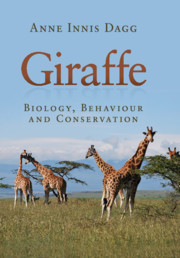Book contents
- Frontmatter
- Dedication
- Contents
- Preface
- Acknowledgements
- List of abbreviations
- 1 Time-line of giraffe
- 2 The giraffe’s environment
- 3 Feeding in the wild
- 4 Social behaviour and populations
- 5 Individual behaviours
- 6 External features
- 7 Anatomy
- 8 Physiology
- 9 Pregnancy, growth, reproduction and aging
- 10 Giraffe in zoos
- 11 Status and conservation of giraffe races
- Appendix Parasites and pathogens
- References
- Index
1 - Time-line of giraffe
Published online by Cambridge University Press: 05 February 2014
- Frontmatter
- Dedication
- Contents
- Preface
- Acknowledgements
- List of abbreviations
- 1 Time-line of giraffe
- 2 The giraffe’s environment
- 3 Feeding in the wild
- 4 Social behaviour and populations
- 5 Individual behaviours
- 6 External features
- 7 Anatomy
- 8 Physiology
- 9 Pregnancy, growth, reproduction and aging
- 10 Giraffe in zoos
- 11 Status and conservation of giraffe races
- Appendix Parasites and pathogens
- References
- Index
Summary
This chapter has four parts. First, a discussion of the contentious topic of why giraffe evolved to have a long neck. Was it for food? Was it for sex? Next is a short section on the ancestors of giraffe which moved into Africa from Asia millions of years ago and eventually died out there. Then a discussion of the DNA of Giraffa camelopardalis itself and what it tells us about the numbers (contested) of subspecies or races spread out over most parts of Africa, information expanded in Chapter 11 on conservation. The chapter ends with an extended description of the giraffe’s place in European history.
Evolution – why are giraffe so tall?
Teachers often use giraffe as a tool to explain conflicting theories of evolution. Lamarck believed that the height of giraffe was caused by the acquired characteristics of its forebears; calves had longer necks because their parents and ancestors had acquired them by reaching up continually to obtain browse to eat. By contrast, zoologists today believe in the selection of natural traits. Changes such as longer necks began by chance mutations in individual giraffids. These individuals were more successful than their shorter-necked friends in that more of their progeny survived to breed themselves. Over millennia the necks of the ancestors of giraffe gradually elongated.
- Type
- Chapter
- Information
- GiraffeBiology, Behaviour and Conservation, pp. 1 - 15Publisher: Cambridge University PressPrint publication year: 2014



